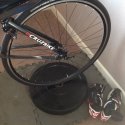Feel free to share my data Ratz!
Ok here's hydrated Larry....
Red box area is pre-structured training. It was planned by Larry but at lacked some of the science the trainer road guys put into their plan designs and that includes resting. Shocking I know but most of use that get the bug hate recovery day and the missing endorphins. (Do Note: Larry's fitness level requires riding harder than the standard TR rides either with longer warms up; or +1+2 more difficult ones).
Reading this graph
Light blue = fitness
Yellow = training load
Purple line = Short term accumulated training load
Blue line = accumulated intensity
To get stronger you have to maintain a negative yellow; without blowing the top off the blue line and over-training.
Starting in June last year fitness began to drop while competing in events and doing usual summer stuff.
There was a big bump of fitness in September during the century a day experiment. Then all fall and winter
without a structured plan fitness stayed level but a lot of effort was put in just to hold the line; intensity was high; load was low.
Starting in March more structure and more sustained load; intensity under control; result steady sustained gains in fitness.
This would be part of the reason N24HC was frustrating for Larry and a good set of lessons best learned at a "B" event; you can have have really good fitness, but that's only part of the problem. Don't put water in the bowl and the big dogs don't bark at the end of the day. That... and training for a 24Hr is different than training for a Century.
But if there is any doubt that structure matters this graph should all but erase that doubt.

Do you have put in constant effort like Larry; no not really. The based fitness holds pretty well. As a comparative example I'm just ending a period of time where training time was going to be light for May and most of June. Below is the same type of graph of myself starting-over with zero fitness in January. It shows there were 3 build blocks; then two months of not much time to train daily due to obligations; hence the planned test rides or "pseudo events" Notice the steady growth of fitness during the training. Lots of consistent effort to build it. But then once built even though I couldn't do a ton of training it holds up pretty well for 2 full months; during which I was out of the home for 2.5 weeks with travel and spent much of the time back scrambling to get caught back up. Maintenance rides scattered in when as possible just to hold off massive decay. This sort of demonstrates how you can indoor train hard in the winter and then ease way up in summer and go out and ride outside and really enjoy the fruits of your offseason work.
Once you build the fitness it's easier to maintain (just don't take 5 months off like I did or you get to start over).
Apologies for the graph overloads but they really do a better job of illustrating what adaptation effects look like; and they are a main tool we'll be using to track progress on the project.
((There are hundreds of charts FWIW, this is just a handy one as cover the big rocks in 1 spot))




